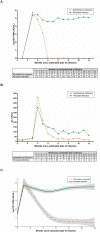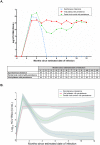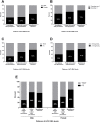Patterns of hepatitis C virus RNA levels during acute infection: the InC3 study
- PMID: 25837807
- PMCID: PMC4383375
- DOI: 10.1371/journal.pone.0122232
Patterns of hepatitis C virus RNA levels during acute infection: the InC3 study
Abstract
Background: Understanding the patterns of HCV RNA levels during acute hepatitis C virus (HCV) infection provides insights into immunopathogenesis and is important for vaccine design. This study evaluated patterns of HCV RNA levels and associated factors among individuals with acute infection.
Methods: Data were from an international collaboration of nine prospective cohorts of acute HCV (InC3 Study). Participants with well-characterized acute HCV infection (detected within three months post-infection and interval between the peak and subsequent HCV RNA levels ≤ 120 days) were categorised by a priori-defined patterns of HCV RNA levels: i) spontaneous clearance, ii) partial viral control with persistence (≥ 1 log IU/mL decline in HCV RNA levels following peak) and iii) viral plateau with persistence (increase or <1 log IU/mL decline in HCV RNA levels following peak). Factors associated with HCV RNA patterns were assessed using multinomial logistic regression.
Results: Among 643 individuals with acute HCV, 162 with well-characterized acute HCV were identified: spontaneous clearance (32%), partial viral control with persistence (27%), and viral plateau with persistence (41%). HCV RNA levels reached a high viraemic phase within two months following infection, with higher levels in the spontaneous clearance and partial viral control groups, compared to the viral plateau group (median: 6.0, 6.2, 5.3 log IU/mL, respectively; P = 0.018). In the two groups with persistence, Interferon lambda 3 (IFNL3) CC genotype was independently associated with partial viral control compared to viral plateau (adjusted odds ratio [AOR]: 2.75; 95%CI: 1.08, 7.02). In the two groups with viral control, female sex was independently associated with spontaneous clearance compared to partial viral control (AOR: 2.86; 95%CI: 1.04, 7.83).
Conclusions: Among individuals with acute HCV, a spectrum of HCV RNA patterns is evident. IFNL3 CC genotype is associated with initial viral control, while female sex is associated with ultimate spontaneous clearance.
Conflict of interest statement
Figures




Similar articles
-
Interferon lambda 3 genotype predicts hepatitis C virus RNA levels in early acute infection among people who inject drugs: the InC(3) study.J Clin Virol. 2014 Nov;61(3):430-4. doi: 10.1016/j.jcv.2014.08.027. Epub 2014 Sep 8. J Clin Virol. 2014. PMID: 25256151 Free PMC article.
-
Factors associated with hepatitis C virus RNA levels in early chronic infection: the InC3 study.J Viral Hepat. 2015 Sep;22(9):708-17. doi: 10.1111/jvh.12384. Epub 2015 Jan 8. J Viral Hepat. 2015. PMID: 25580520 Free PMC article.
-
Hepatitis C Virus Reinfection and Spontaneous Clearance of Reinfection--the InC3 Study.J Infect Dis. 2015 Nov 1;212(9):1407-19. doi: 10.1093/infdis/jiv220. Epub 2015 Apr 15. J Infect Dis. 2015. PMID: 25883387 Free PMC article.
-
Dynamics of HCV RNA levels during acute hepatitis C virus infection.J Med Virol. 2014 Oct;86(10):1722-9. doi: 10.1002/jmv.24010. Epub 2014 Jul 8. J Med Virol. 2014. PMID: 25042465 Free PMC article.
-
Host and viral determinants of the outcome of exposure to HCV infection genotype 4: a large longitudinal study.Am J Gastroenterol. 2014 Feb;109(2):199-211. doi: 10.1038/ajg.2013.427. Epub 2014 Jan 21. Am J Gastroenterol. 2014. PMID: 24445571
Cited by
-
Evaluation of the Aptima HCV Quant Dx Assay Using Serum and Dried Blood Spots.J Clin Microbiol. 2019 Mar 28;57(4):e00030-19. doi: 10.1128/JCM.00030-19. Print 2019 Apr. J Clin Microbiol. 2019. PMID: 30760534 Free PMC article.
-
HCV incidence is associated with injecting partner age and HCV serostatus mixing in young adults who inject drugs in San Francisco.PLoS One. 2019 Dec 10;14(12):e0226166. doi: 10.1371/journal.pone.0226166. eCollection 2019. PLoS One. 2019. PMID: 31821365 Free PMC article.
-
T-Cell Immunity against the Hepatitis C Virus: A Persistent Research Priority in an Era of Highly Effective Therapy.Cold Spring Harb Perspect Med. 2021 Jan 4;11(1):a036954. doi: 10.1101/cshperspect.a036954. Cold Spring Harb Perspect Med. 2021. PMID: 32205413 Free PMC article. Review.
-
Modeling of patient virus titers suggests that availability of a vaccine could reduce hepatitis C virus transmission among injecting drug users.Sci Transl Med. 2018 Jul 11;10(449):eaao4496. doi: 10.1126/scitranslmed.aao4496. Sci Transl Med. 2018. PMID: 29997251 Free PMC article.
-
Role of HCV Viremia in Corroborated HCV Transmission Events Within Young Adult Injecting Partnerships.Open Forum Infect Dis. 2019 Apr 25;6(4):ofz125. doi: 10.1093/ofid/ofz125. eCollection 2019 Apr. Open Forum Infect Dis. 2019. PMID: 31041340 Free PMC article.
References
-
- Busch MP. Insights into the epidemiology, natural history and pathogenesis of hepatitis C virus infection from studies of infected donors and blood product recipients. Transfus Clin Biol. 2001;8(3):200–6. - PubMed
Publication types
MeSH terms
Substances
Grants and funding
LinkOut - more resources
Full Text Sources
Other Literature Sources
Medical

